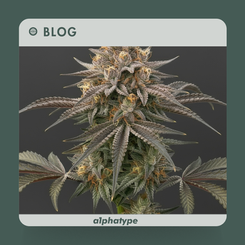Blog: Defining your Breeding Goals: Immediate Return v. Sustainable Value
- alphatype
- Jul 6, 2023
- 4 min read
Updated: Feb 25
Published 9:00 AM EST, Thu July 06, 2023
Cannabis breeding lags behind other plant species.
Industry dynamics don’t favor long-term investing.
Major breeding milestones are up for grabs.
The get-rich-quick mentality that dominated the cannabis sector since business-enabling regulation started spreading beyond California and Colorado across the globe created many overnight millionaires. From fast-reacting marijuana old-timers to opportunistic suits rehashing the perennial equity pump playbook, those who got in early and executed with discipline reaped great rewards. Most of those chasing the wave missed it. Because that's how business, and often life, works, right?
Cutting corners is not an option in plant breeding -unless you’re using CRISPR and literally cutting genes, but that’s a different conversation. Although a breeder’s toolbox is increasingly being enhanced with tech-based solutions, time-to-know remains the most frustrating speed bump. Observing, selecting, hypothesizing and repeating can only be expedited so much.
So how does a cannabis breeding team resolve the tension between the slow nature of their science and the fast-paced developments in the industry?
Zoom Out.
When compared to other plant species farmed for food, pharma or industrial use, cannabis breeding is in its infancy. Research was off-limits for universities and corporations until yesterday, plant variety protection still has long ways to go, and demand for advanced genetics remains marginal in 2022. If you’re in the business of cannabis breeding today, the upside is virtually unlimited. The pie is on track to grow at such an exponential rate over the next decades that the outlook looks fail-safe even for average performers.
Resist temptations, delay gratification.
Insiders in this industry niche know how informal most leading starting material providers are. The sector is ridden with dubious claims, unfulfilled promises and outright lies. These antics went unchallenged when the main entry barrier -illegality- limited competition to a few underground players in the Netherlands (operated from Spain) and the American Northwest (Humboldt, Oregon, Washington). But as legality spreads globally and institutional capital flows into the sector, so does demand for accountability and standards. Fast money today, when built on shaky foundations, will likely cost you dearly in the long run.

Silence the hype, focus on fundamentals.
Breeding THC down off cannabis strains and stabilizing varieties that consistently produce flowers containing below the 0.3% THC legal threshold is arguably the industry’s biggest milestone over the last 20 years. Kudos to the pioneers - you know who you are. That innovation created an entire industry, the CBD phenomenon, that will grow and evolve indefinitely. Does that mean that breeding strains that maximize the isolation of other cannabinoids, like CBG or CBN is as good a bet? What was the real achievement behind these high-CBD cannabis strains? Was it the high amount of CBD or the low amount of THC, that made it legal to grow and research cannabis under hemp regulation, like the 2018 Farm Bill in the US?
Apply lessons learned from other plant species.
The prehistoric state of cannabis breeding today is a blessing in disguise. What happened to American corn over the last century? How did Colombian cut flower producers put their Californian counterparts out of business? Why are pharma conglomerates like Bayer invested in plant breeding? Cannabis breeders get to look into these case studies for valuable insights into how the industry may evolve. No need to reinvent the wheel just yet.
Solve one problem at a time.
One of the main challenges in breeding, given the large amounts of data generated, is isolating variables. Set one goal at a time and make sure your progress is scientifically robust before you move on to the next. If you want to solve 3 different problems at the same time, create three independent breeding projects that are clearly differentiated. Breeding mold vulnerability out of your favorite strain for your specific growing conditions is already a significant breeding success, one that would likely take you two to three years of sound research and precise execution. Don’t try to increase yield or THC levels at the same time.
Breeding industrial hemp for the tropics.
Alphatype’s first breeding project was defined in 2018, taking into account all the above. When we set out to breed an industrial hemp strain viable for subtropical regions, considering their unique, yearlong 12/12 daylight cycle we knew this would be a long, challenging endeavor. We knew there wouldn’t be any short-term returns, meaning more in-house funding. We believe hemp, especially industrial-use primary products, is coming back in a big way. And that producers in South America, Western Africa and SouthEast Asia hold a significant competitive advantage over traditional, Northern Hemisphere producers like the US, France or even China. Focusing only on reducing photo-dependency allowed us to allocate all our resources on just one variable, one for which there was existing, applicable research we could build on. Progress has been slow, as expected, but extremely promising.
It will probably be another two years before we’re ready to put our seeds in the market, but seven years of research will feel like a blink of the eye considering the potential impact of redefining the supply chain of an entire industry across the globe's tropical ring.
























































